This is a traditional Filipino recipe for pancit bihon. Very easy to prepare, my chewy rice noodles are tossed with vegetables and chicken, and cooked in a sweet and savory sauce. Not only is it delicious, my pancit recipe only takes 25 minutes to make from start to finish.
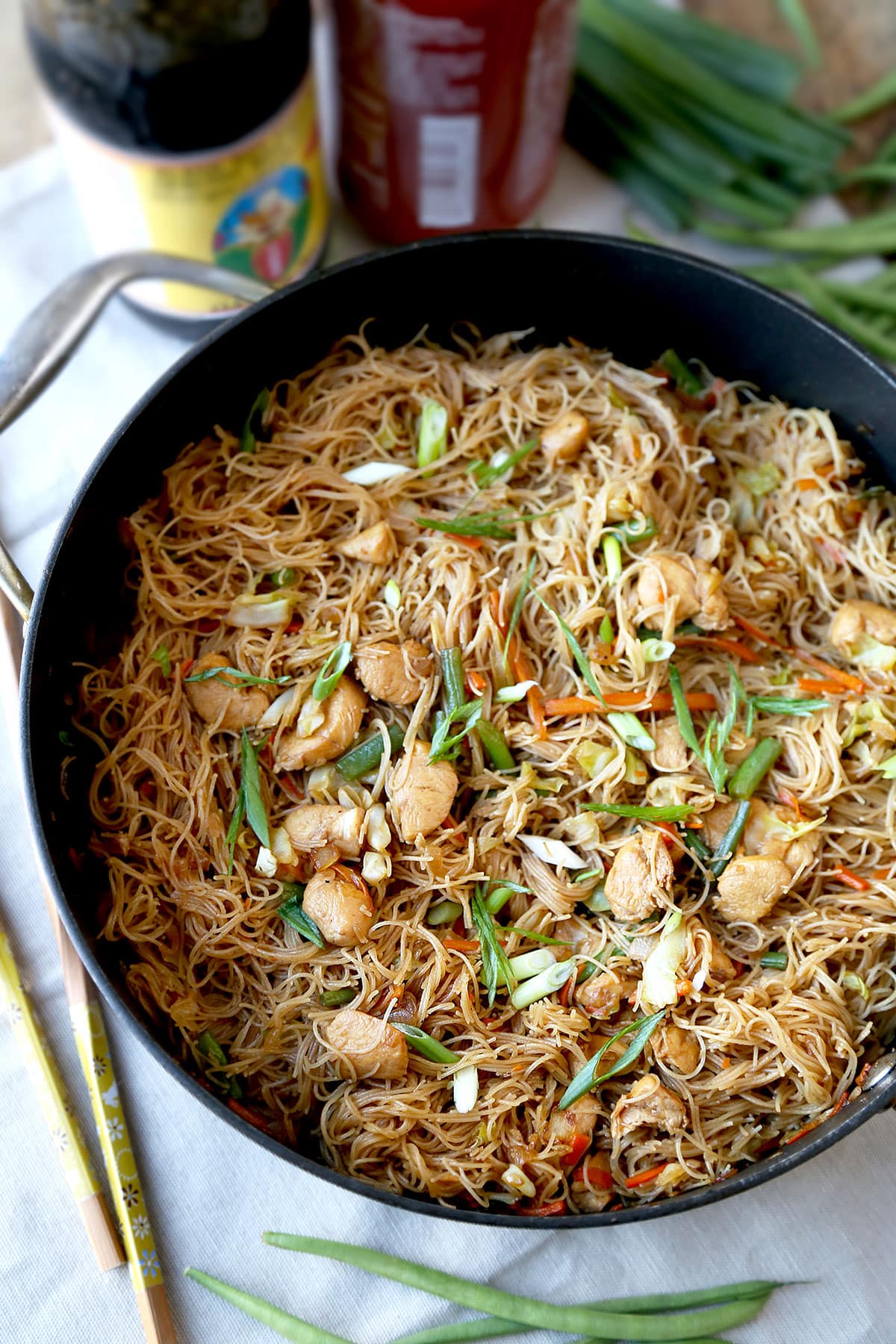
Why I Love This Bihon Pancit Recipe
Bihon pancit is one of those recipes I enjoy making because of its savory and earthy flavors. Let’s face it: Filipino dishes nail the comforting element. Think of dishes such as arroz caldo, chicken tinola, and the delicious seafood sinigang. They always bring so much flavor to the table! Even a simple dish like pancit bihon made of rice noodle, mixed vegetables, chicken, and seasoned with a savory and slightly sweet brown sauce, comes packed with flavor.
Don’t be surprised if you are going in for seconds! Making pancit is also very affordable and can be made using ingredients you most likely already have in your fridge and pantry.
Table of Contents
Origins Of Bihon Pancit
Pancit originally hails from the Philippines where Chinese migrants worked as street vendors during the Spanish colonial times. They were known as panciteros. Panciteros mainly sold meals to women who worked in cigar factories because they had very little time to cook at home.
It was during this time that street food became synonymous with convenience and quality. Noodles – being one of the most convenient to-go, ready made foods – were commonly served at these food stalls.
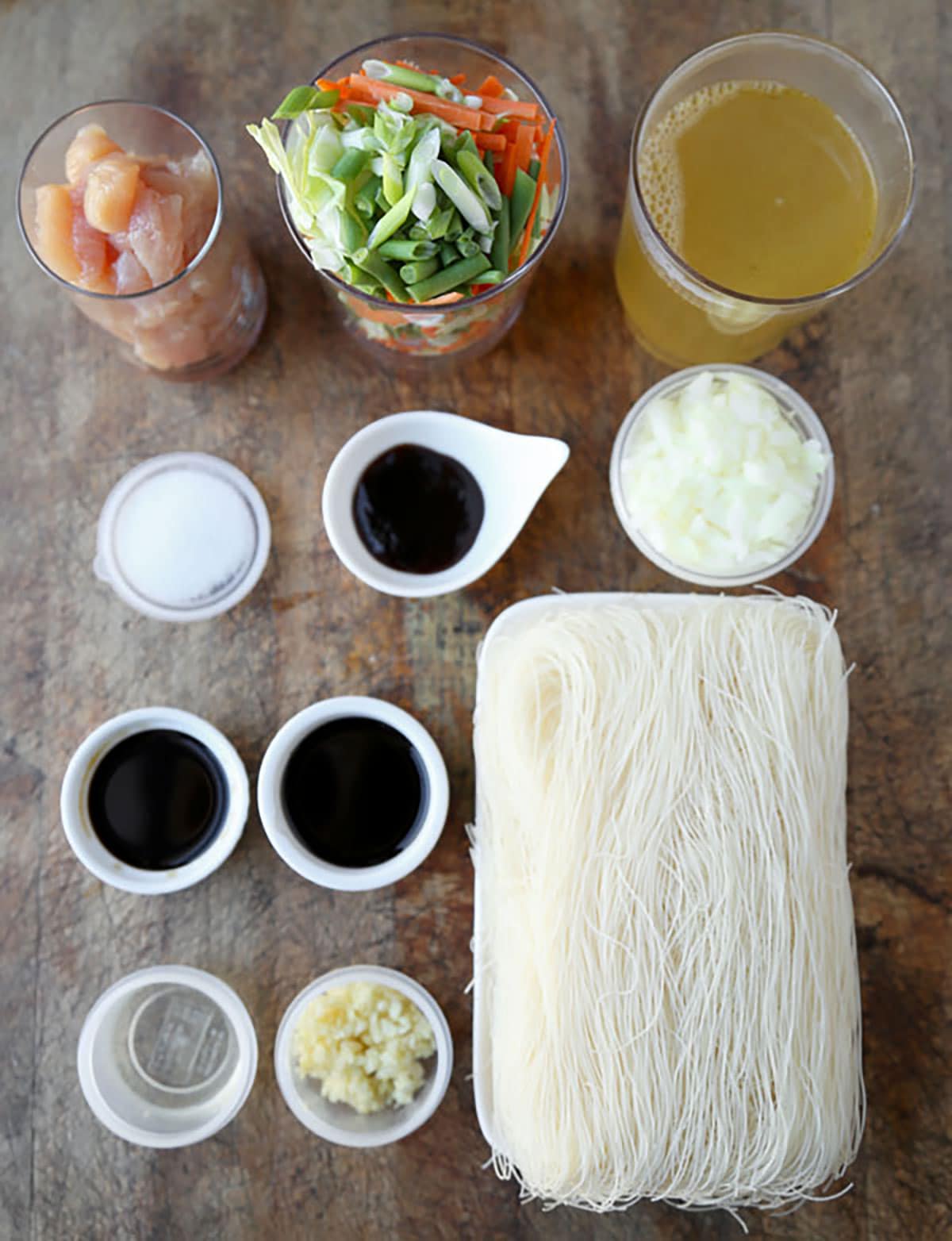
Bihon Pancit Ingredients
Scroll to the bottom of this page for the full recipe steps and measurements.
- Peanut Oil: Most Asian recipes call for peanut oil for its nutty flavor. However, you can use a neutral oil such as vegetable or grapeseed oil to make this dish and it will be just as good.
- Chicken Breast: I use boneless, skinless chicken breast for this recipe since the chicken needs to be cut into bite size pieces. But you are more than welcome to use bone-in with skin on if you are planning to serve it on top of the pancit. Cook your chicken in a separate pan until it’s cooked through and follow the same steps to the recipe.
- Garlic: I’m using two cloves, minced, to add a little pungency but you can use more if you are a garlic lover.
- Onion: I’m using a small yellow onion and chopping it into small pieces. If you don’t have a yellow onion but happened to have a white one, red one, or some shallots, that’s fine too.
- Bihon Noodles: Bihon noodles are thin noodles made of cornstarch and rice flour. They are very similar to thin rice noodles and vermicelli noodles which is why both make good substitutes.
- Mixed vegetables: I’m using a mix of green beans, carrots, and cabbage, but you can have fun here and come up with your own combination.
- Pancit Sauce: A mix of low sodium chicken stock, dark soy sauce, soy sauce, oyster sauce, and sugar.
- Salt and Pepper: Only add if you think it needs extra seasoning.
Other Proteins To Use Beside Chicken
Pancit can be made using any protein you like. This recipe is made with chicken but feel free to use:
- Seafood: Shrimp, squid, or a firm fish such as arctic char or salmon, work well with the flavors of pancit.
- Beef or pork: For something heavier, beef or pork will complement this noodle dish.
- Tofu or tempeh: For vegetarians or if you simply want a meat-free meal, use firm tofu or tempeh. Tvp (textured vegetable protein) also works well.
*To make this dish completely vegan, use vegetable broth and a vegan oyster sauce.
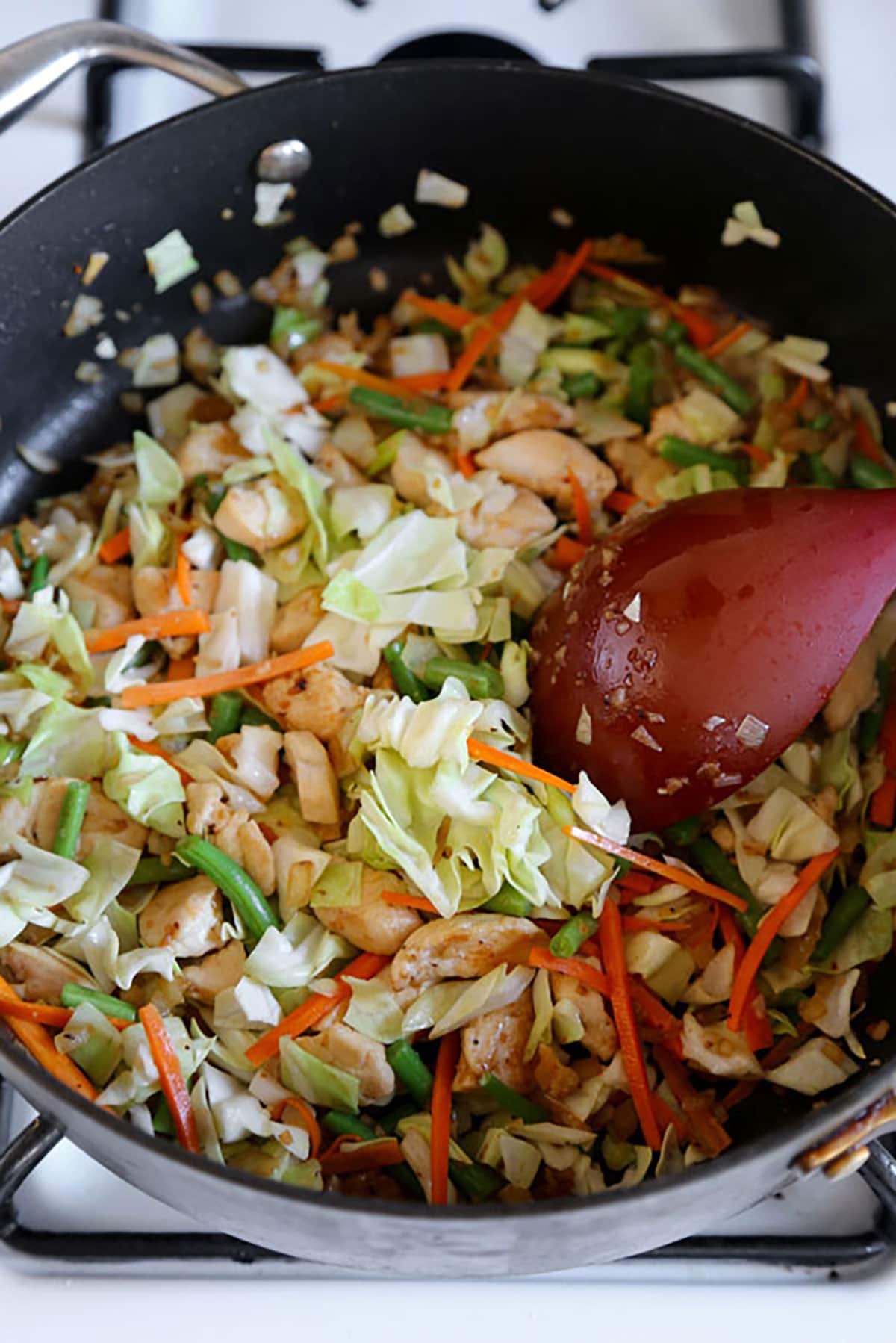
How to Make Bihon Pancit
Scroll down to the recipe card for the full recipe.
When whipping up my bihon pancit recipe, I like to get all my ingredients laid out in front of me. Doing my mise-en-place ahead of time frees me up to pay 100% attention to the task at hand.
- Sauce. Whisk all the ingredients for the sauce in a bowl and set aside.
- Chicken. Add a little oil to a deep skillet and cook the chicken. Transfer the chicken to a plate and set aside.
- Garlic and onions. Cook the garlic and onion until they are fragrant.
- Cooked chicken and veggies. Return the chicken to the skillet and add the vegetables. Stir fry until the vegetables are soft but still yielding a little crunch.
- Add the sauce. Whisk the sauce, add it to the pan, and bring it to a boil.
- Cook the noodles. Add the rice noodles and gently press them down so they are evenly coated with the liquid. Cook until the noodles are tender.
- Season and serve. Turn the heat off and transfer the dish to a serving bowl or plate. Serve with soy sauce and lemon wedges.
Expert Cooking Tip
Perfectly cooked vegetables: Getting the right texture for the vegetables is quite important for this recipe. You want the vegetables to be tender but still yield a slight crunch, which is why they are added later during the cooking process. 2 to 3 minutes should be plenty of time to start them off before the sauce is added. The balance between moist and tender chicken and slightly crunchy veggies makes every bite enjoyable.
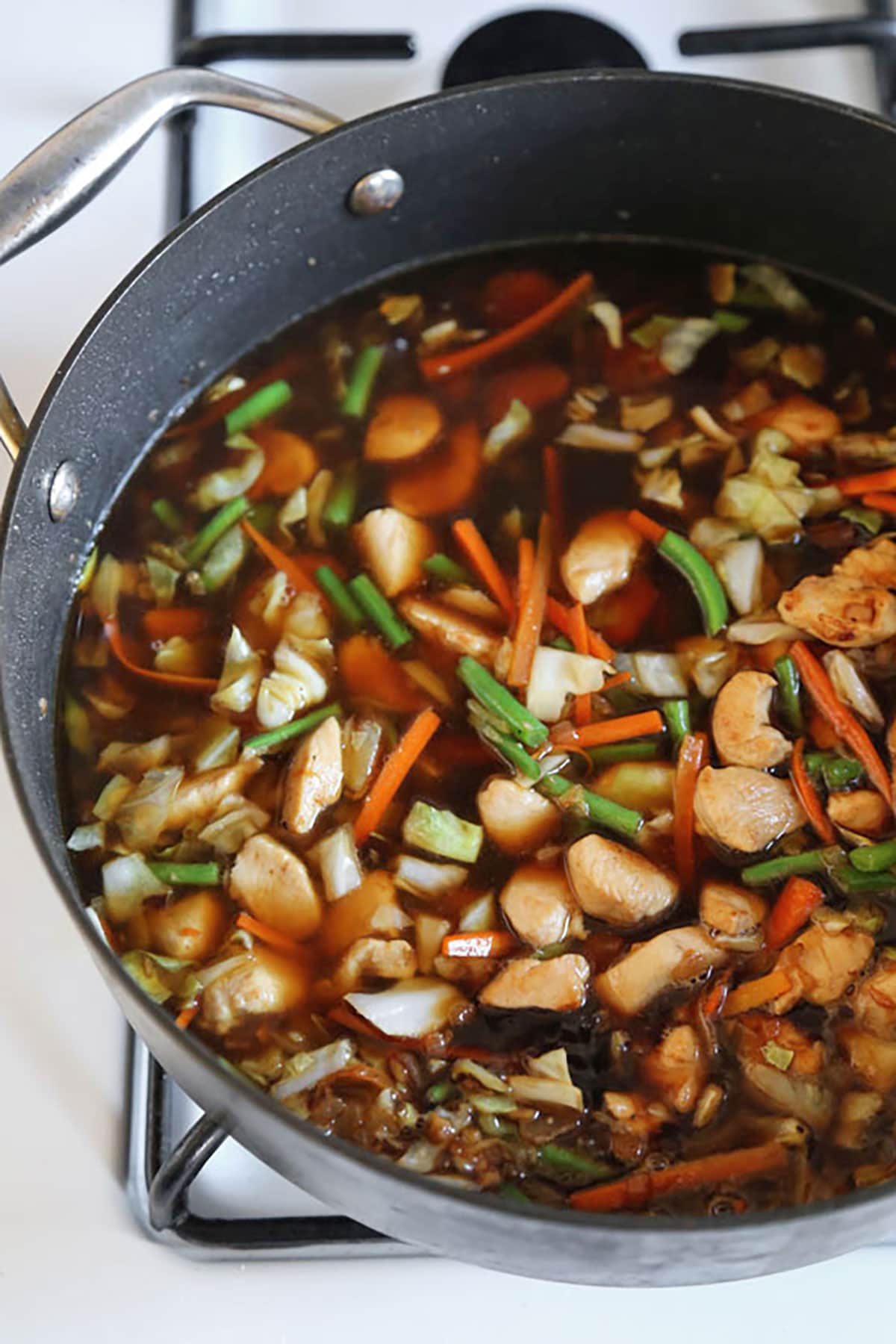
Storage And Reheating
Fridge: Let the dish cool to room temperature and transfer it to an airtight storage container. Refrigerate for up to 3 days.
Freezer: It’s best not to freeze this dish because the texture of the noodles will deteriorate.
Reheating: To reheat from the storage container (make sure it’s microwave safe), slightly open the lid and microwave on medium or high for 1 to 2 minutes. Or transfer the noodles to a microwave safe bowl or plate and cover the dish with a damp paper towel to prevent the noodles from drying. Microwave on medium or high for 1 to 2 minutes.
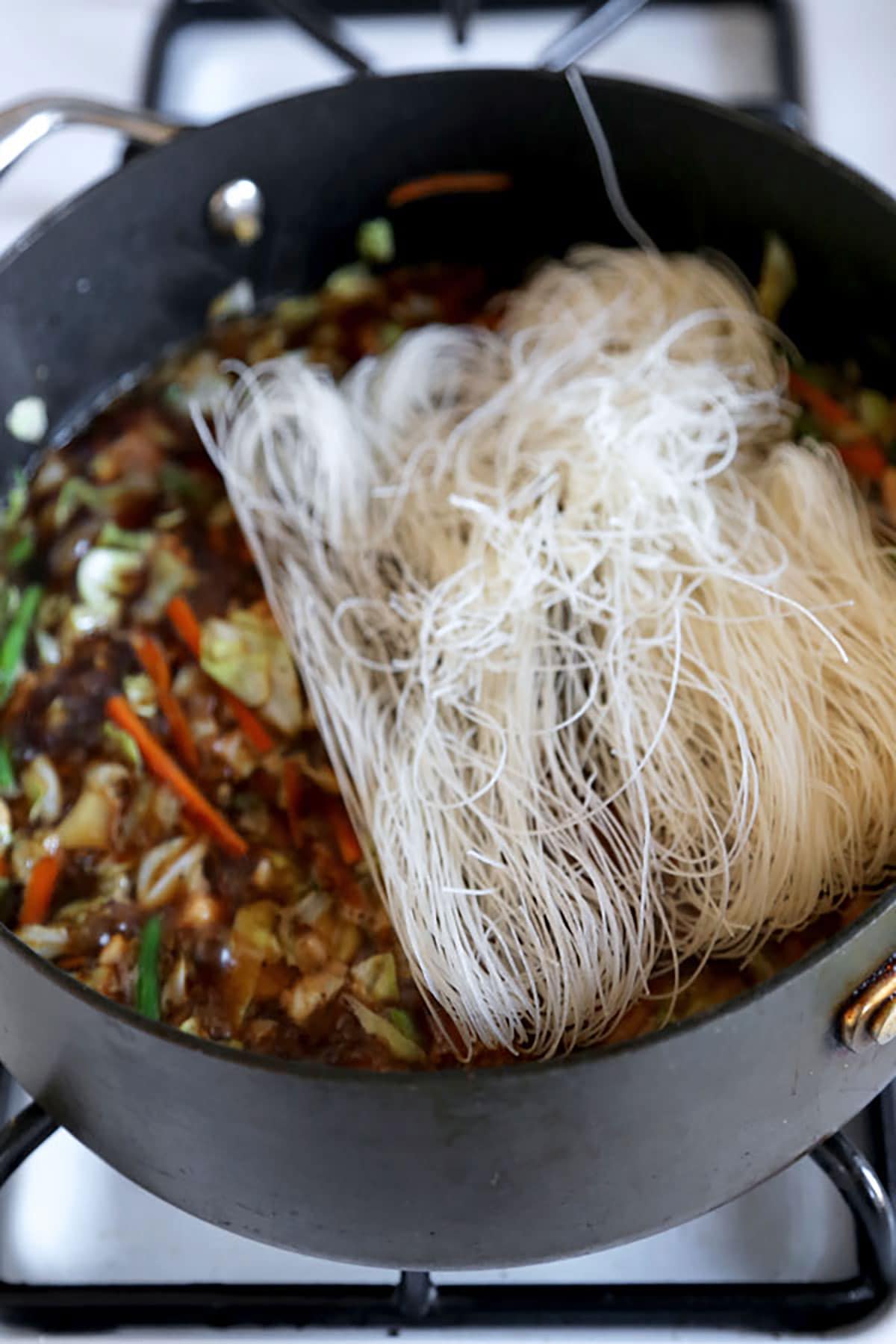
What to Serve With It
Bihon pancit is a filling dish that is usually served as a main. But it does pair well with plenty of side dishes, especially Asian ones! Some of my favorites are:
- Pandesal (Filipino breakfast roll)
- Chinese eggplant with garlic sauce
- Dry-fried green beans
- Smacked cucumber with chili oil
- Chicken egg foo young
- Green salad with restaurant-style Japanese ginger dressing
More tasty noodles dishes you might like: Dan dan noodles, spicy miso ramen, kimchi udon, shrimp chow mein, Singapore chow mei fun, and fried noodles with soy sauce.
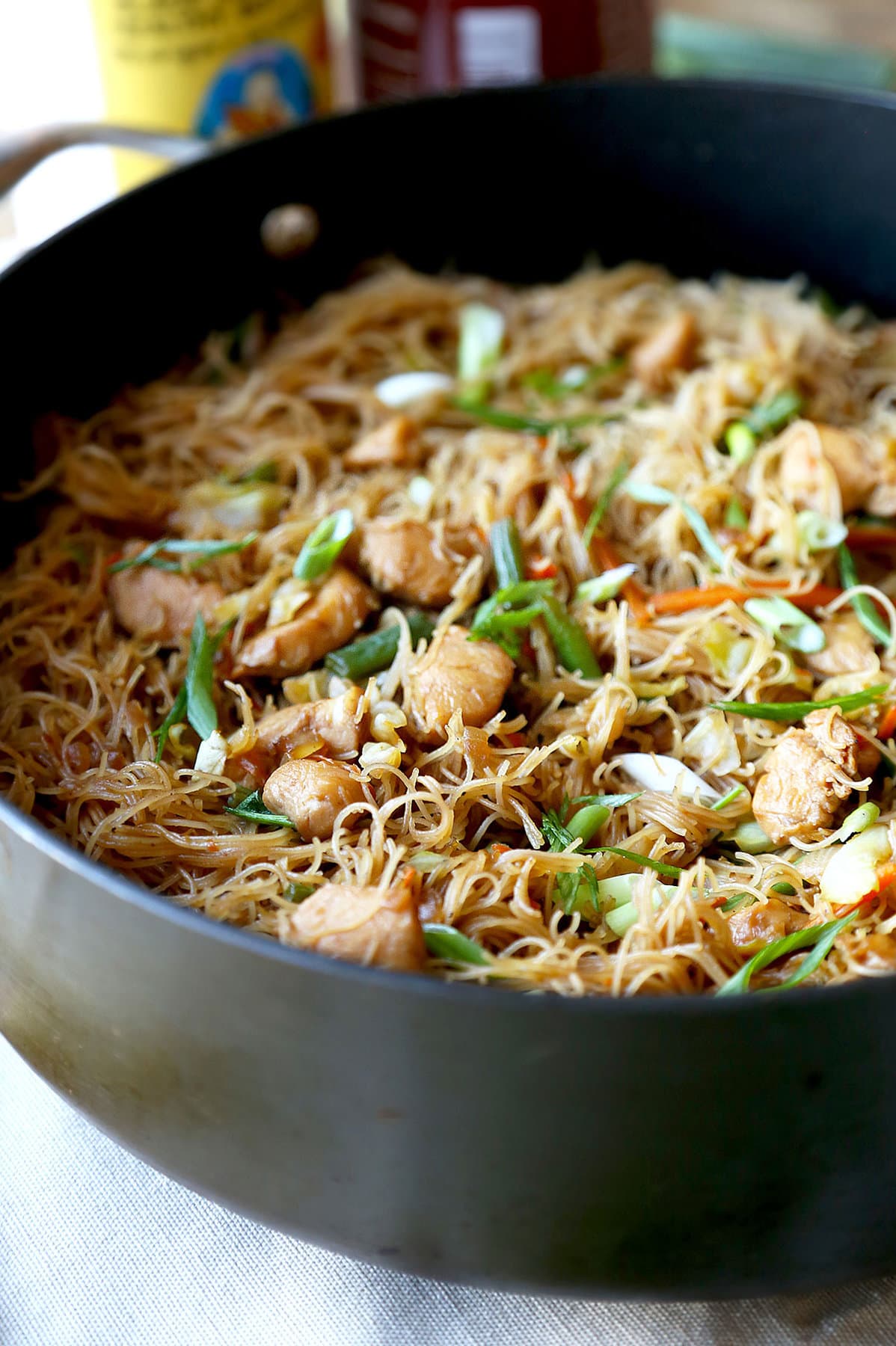
Frequently Asked Questions
Since the noodles cook by absorbing the sauce, you may just need to add a bit more broth. Even though I have the measurements dialed in for this recipe, I usually keep about a half-cup of chicken broth on hand just in case I need a bit more. Add a little at a time if needed, until the noodles are tender – but not so much that your pancit turns out soupy.
Overcooking: Tossing the the noodles in the skillet for too long can overcook the noodles and give them a mushy texture. Too old: Noodles that are 2-3 years or older can yield a mushy texture once cooked. Dry noodles should also be kept somewhere dry and cool place to prevent humidity from affecting their texture.
Regular soy sauce: yes. (Although, celiacs can substitute liquid aminos or tamari instead). Soy sauce brings needed salt and umami to the dish. Dark soy sauce: optional. Dark soy sauce is mildly savory and a little sweet. It is used as a food coloring as much as it is for flavor. Dark soy introduces a dark, tawny color to dood. If you don’t have dark soy sauce on hand, don’t worry. Since I only use 2 tablespoons in my pancit recipe, you can just use regular soy sauce. The end dish will be lighter in color, but just as tasty.
No, pancit canton is not the same as pancit bihon. The main difference between the two is the type of noodles used. Pancit bihon calls for bihon noodles (thin rice vermicelli, sometimes called rice stick noodles), whereas pancit canton uses flour stick noodles. These pre-fried wheat based noodles are closely related to lo mein noodles.
Pancit palabok is made using rice stick noodles that are then covered in a thick and gooey shrimp gravy.
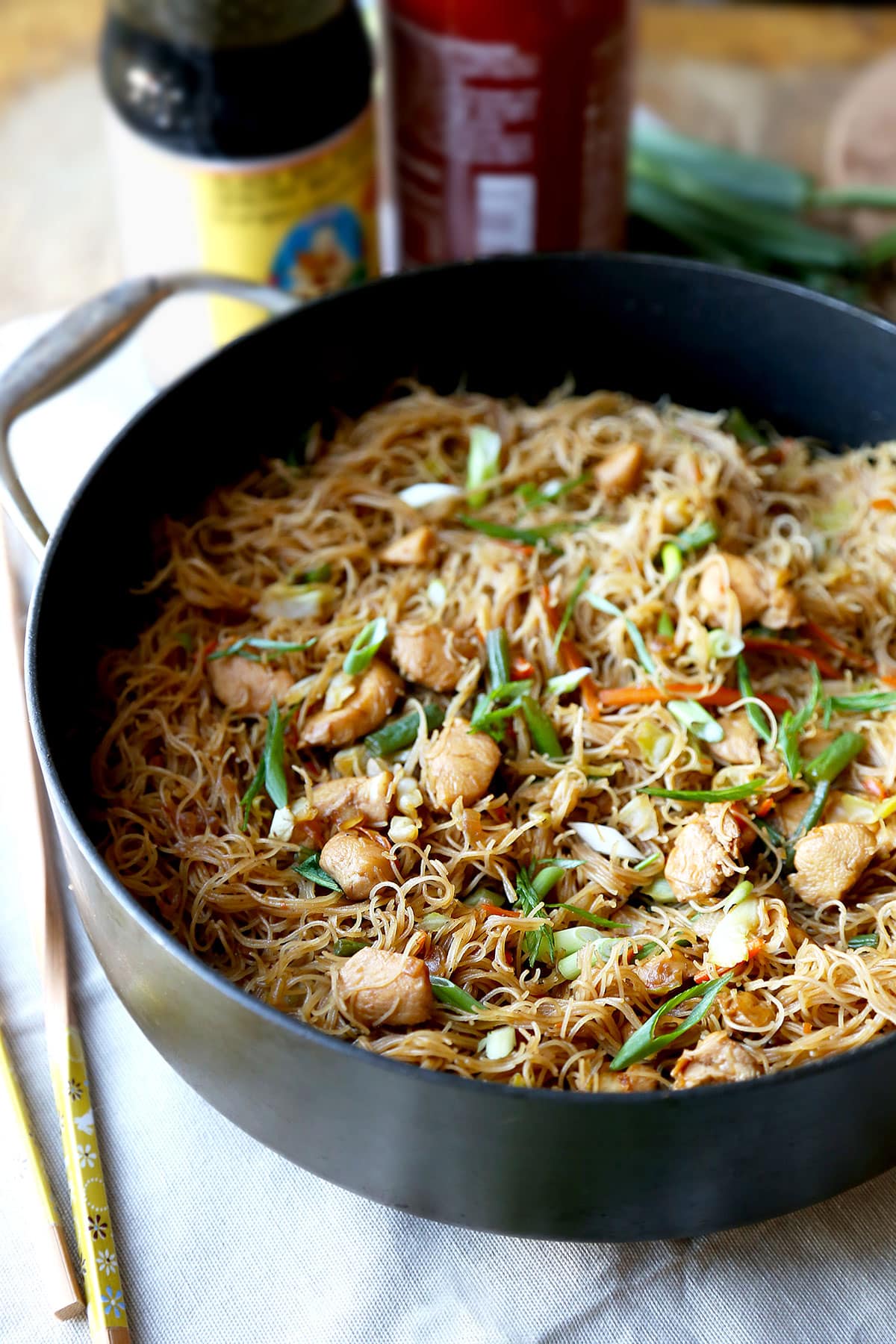
Did you like this recipe? Are there changes you made that you would like to share? Share your tips and recommendations in the comments section below!
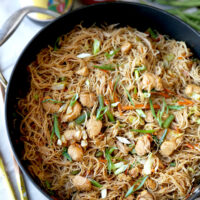
Bihon Pancit (Filipino Stir Fried Noodles)
- Prep Time: 10 minutes
- Cook Time: 10 minutes
- Total Time: 20 minutes
- Yield: 4 1x
- Category: Noodles
- Method: Stir frying
- Cuisine: Filipino
Description
A sweet and savory Filipino pancit recipe ready in less than 25 minutes. Plus, it requires minimal effort and uses easy to find ingredients.
Ingredients
- 1 tablespoon peanut oil or vegetable oil
- 1 pound boneless, skinless chicken breast, sliced into bite size pieces
- 2 cloves garlic, minced
- 1 small onion, finely chopped
- 8 ounces pack bihon noodles, vermicelli noodles or rice noodles
- 1 1/2 cups mixed vegetables such as carrots, cabbage and green beans, scallions, chopped bite size
- Salt and pepper, to taste
- Lemon wedges (optional)
Pancit sauce:
- 2 cups low sodium chicken stock or vegetable stock for vegan
- 2 tablespoons dark soy sauce
- 2 tablespoons soy sauce
- 1 tablespoon oyster sauce or 1 tablespoon soy sauce mixed with 1/2 teaspoon sugar for vegan
- 1 teaspoon sugar
Instructions
- Cook the chicken. In a wok or a large deep skillet over medium heat, add oil and chicken and cook until tender. Once cooked, transfer the chicken to a plate and set aside.
- Cook the garlic and onions. In the same skillet, add the garlic and onion and cook for 2 minutes.
- Add the cooked chicken and veggies. Return the cooked chicken to the skillet and season with a little salt and pepper. Stir in the veggies and cook for 2 to 3 minutes or until they have begun to soften.
- Sauce. Add all the ingredients for the pancit sauce and bring to a boil.
- Add the noodles. Once the sauce is boiling, add the rice noodles and stir until all the noodles are coated with the sauce. Keep on stirring and cooking until the noodles are tender (3 to 4 minutes). Add more stock (or water) if the dish is dry.
- Season and serve. Season with salt and pepper and more soy sauce if necessary. Serve immediately with lemon wedges.
Notes
Storage: Save leftovers in an airtight storage container and refrigerate for up to 3 days.
Reheating: To warm up the leftovers, microwave on high for 1-2 minutes, with the lid slightly ajar.
Variations: Use other proteins such as beef, pork, shrimp, or tofu. And feel free to mix them up too! For a nutty taste, add a drizzle of sesame oil. For a little heat, drizzle a little chili oil. And for some sweetness, try a squirt of tonkatsu sauce or sweet chili sauce.
Nutrition
- Serving Size: 1 serving
- Calories: 506
- Sugar: 3.4g
- Sodium: 1022mg
- Fat: 8.1g
- Saturated Fat: 1.6g
- Unsaturated Fat: 2.1g
- Trans Fat: 0g
- Carbohydrates: 68.9g
- Fiber: 6g
- Protein: 36.7g
- Cholesterol: 82.7mg
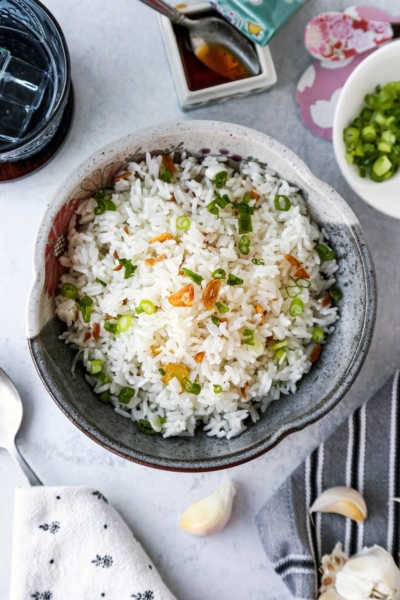

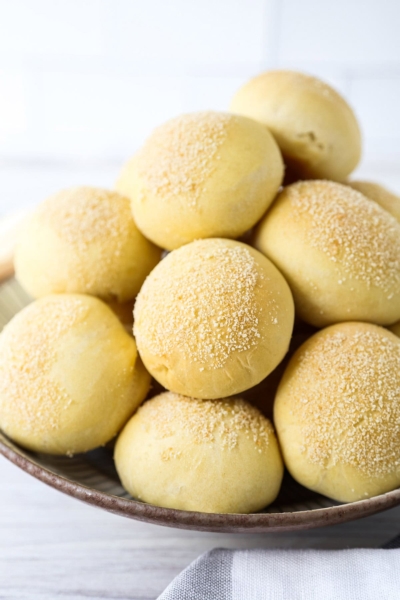
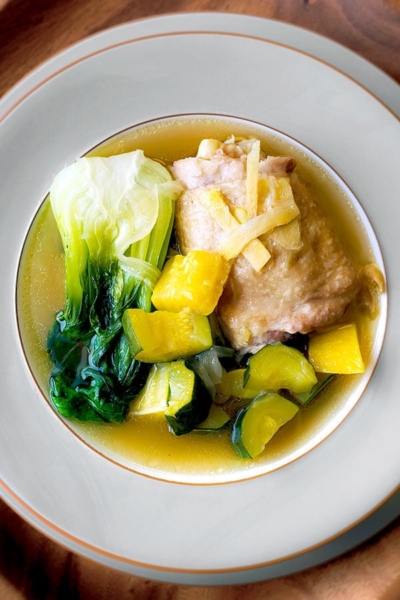















Questions and Reviews
This recipe was AMAZING!!! I made it for family dinner tonight and it was a hit! It was great! Thank you!
Thank you so much! 🙂
I couldn’t find an oyster sauce that didn’t have soy in it- due to allergies. Can I substitute fish sauce or just more coconut aminos?
Hi Bernice! You can use the aminos and add a pinch of sugar to the sauce. This should work nicely 🙂
Due to food allergies, I can’t have soy. I’d still love to make this for my husband and me for our upcoming anniversary- he loves pancit!
I usually used coconut aminos as a substitute in dishes that call for soy sauce. Could I use coconut aminos in this as well? Since the recipe calls for two types of soy sauce, is there something else I’d need to add to get the same flavor as the original recipe?
Hi Bernice! Yes, you can use liquid aminos for this. You could add a little more sugar to bring it closer to the original flavor but other than it will be good 🙂
Hi Bernice, if u can hve Beagg”s Amino liquid, you can use that instead of soy sauce. Also, if you can, use fish broth. Its called: Patis.(pronounced: pa-tese) Asian markets carry it. its added to the dish, after cooking. Some ppl dont like it, so its put on the food after it is served on the plate/ bowl. Go sparingly!! Its strong. I LOVE! it, nd I use A Whole Lot!! On my plate, not in the whole dish.
Best to eat this when it’s “Meryenda” time. So yummy!
Just wondering if I could completely omit the oyster sauce due to allergies. And if so do I add more soy sauce?
Hi Nina! Yes you can and use more soy sauce instead. You could also add a little sugar, like half a teaspoon 🙂
Followed the recipe down to the letter and I couldn’t be happier with it! I’m Filipino and have eaten pancit since I was a kid. Growing up I tried a few variations of pancit and this version was always my favorite. As I finished cooking tonight, I couldn’t help but get a huge grin on my face as I tasted the finished meal – it’s EXACTLY the type of pancit I’ve loved since I was a kid! Thank you so much for providing such an easy recipe for my wife and me to follow. Can’t wait to make this for our future family!
Thank you so much Erik, you have made my day! 🙂
Thank you so much for this recipe. This recipe is delicious and very easy to make.
Thank you Barbara! 🙂
This is a great recipe. Squeez abit of lemon and lime on it and it’s perect. Very tasty.
Thank you Jacob!
Been making pancit for years. Two things, I never heard of dark soy sauce and I never added uncooked bihon noodles to the chicken/veggie mix. I used to soak my noodles. I can’t wait to try this recipe tomorrow. I never added green beans, just cabbage, carrots, onions & garlic. I will add green beans. I looked in my cabinet and I have 3 unopened bottles of oyster sauce! Why? We’re forever making lumpia egg rolls. Thanks for the recipe!
Bihon is the bet! I hope you enjoy this recipe Linn! 🙂
Not sure where I went wrong but the dark soy sauce overpowered everything. Dark brown noodles looked nothing like the picture when I followed the recipe. It was my first time making pancit, but I have eaten it before. Maybe I used the wrong brand of dark soy?
Alex, I think you are right about the soy sauce. There are a lot of different types out there and some of them are really thick, sweet and salty. Next time I would suggest skipping the dark soy sauce and only using regular soy sauce.
i cant wait to try this!
Can i substitute the chicken with shrimp?
Hi Jackie! Yes, you can substitute with any protein you like. The only thing I would suggest is to fry the shrimp separately and add them to the bihon right before serving to prevent them from overcooking 🙂
My family really enjoyed this meal. Had to make a few subs due to limited ingredients on hand and it worked well! I did not have snow peas; I added celery. I did not have dark soy sauce so I mixed 4 tsp regular tamari, 1 tsp molasses and 1/4 tsp cane sugar as a replacement. I did not have oyster sauce so I mixed enough fish sauce and hoisin sauce to equal the oyster. I also used pork instead of chicken. Topped it all with chili flakes and it was delish!! Thanks for the recipe!
Natalie, you are such a wizard in the kitchen! Thank you for sharing your substitutions, such great ideas! 🙂
NOT soaking the noodles in water first is KEY!!! Was so much more flavorful this way! The noodles really soak up the sauce and make it so yummy! Thank you for this recipe.
I tried this and oh my goodness. I added anit more soy sauce and oyster sauce and about 2more cups of stock to mine and it was divine. My biggest problem was always over-soaking it even if I follow pack direction but putting it in pan to cook from start and it retains its shine at the end. Simply awsome
Hello Ann, I’m wondering what you mean by “pre-soaking the noodles.” ???? Rice noodles are nothing like semolina pasta. Its not even pasta.
The rice noodles cook instantly! As soon as they hit the fluid.
I’m Filipino, Pancit is 1 of my comfort foods. We’ve never pre-soaked the noodles. My grandpa, nor my mom, uncle, aunts, sisters, brothers, myself. Like I said they cook instantly!! When they touch the fluids. I being chickenbroth to a boil, remove frm heat, drop in the noodles. Add the meat n veggies. Finished all the cooking.
Is there a substitute for Oyster sauce in this recipe? I have a shellfish allergy and I’m hesitant to use it. Thank you!
Look for vegetarian “oyster” sauce in the same aisle they sell regular oyster sauce. The vegetarian version is made with mushrooms and just as good as regular oyster sauce.
Thank you Adora for the tip!
Very good as written. Great with a few changes: softened noodles in warm water for 30 minutes for easier handling, drained, doubled garlic, oyster sauce, sugar, and veggies (we love them!), added 1T rice vinegar mixed with 1/2 C reserved broth at the end along with chicken to avoid overcooking. Even better with sauteed shrimp!
Hi, Is the standard Kikkoman soy sauce suitable for the soy sauce & then use a second dark soy sauce with it? I ask, because I thought basic brand Kikkoman was Considered a dark soy sauce. Also, is Oyster Flavored Sauce suitable for Oyster Sauce, or is there a large difference in flavor?
Hi John! Yes, Kikkoman is fine and oyster flavored sauce is perfect (Lee Kum Kee is my favorite)! 🙂
Hello John, Kikkoman is Japanese soy sauce, nd Very salty. Try to find Filipino soy sauce. ‘Pinoy’ is on most Filipino products. Its a small icon. Asian markets carry Pinoy. You can eliminate oyster sauce all together. Filipino cooking, traditionally – is use what you have, use what you like.
I hope this helps.
P.s. I’m Filipino. My grandpa taught me how to make Filipno dishes.
Thank you for this simple and delicious recipe. I love pancit and have had this a few times in the past. I had most ingredients on hand after finding bihon at the market. I only had gluten free soy sauce so only used that and it was still wonderful. Such an easy basic recipe- definitely removed the fear factor of trying to make this dish. Family loves it too!
I just cooked this and my picky teenager tore into this and loved it!! Super easy, just like my best friends (who is Filipino). Yum thanks
I will try to make this today! I have a question can I add cabbage to this?
Hi Roxanne! You can add anything you want to this recipe, it’s so easy to make and I personally love lots of veggies. The more the merrier 🙂
I’m so happy you posted this recipe! Being native Hawaiian, born and raised in Hawai’i with all the delicious dishes from Polynesia and the different countries of Asia, I have always been in love with Pancit Bihon. This dish goes perfectly with some pinakbet and a little chicken adobo on the side!
Genny,
AMEN!! I’m Filipino. Lived in Hawai’i, for a time. Love, love, love the foods.
This is so nice looking. Gotta make it soon. I like that it is not too saucy.